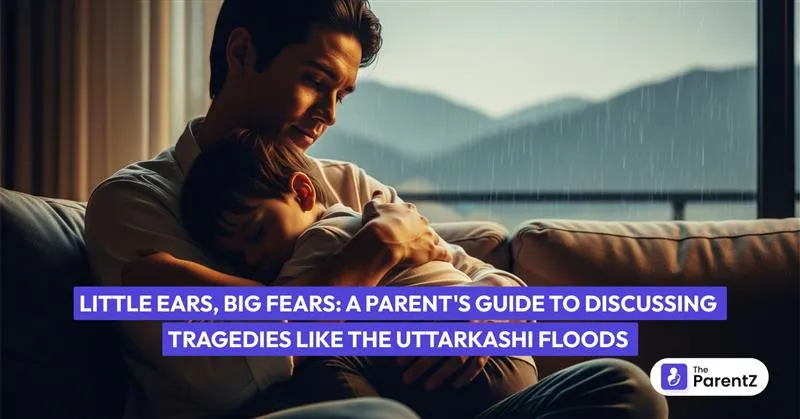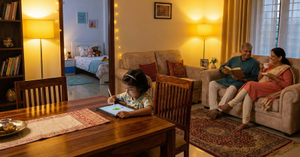In today’s world, little ears often hear more than we expect. Your eight-year-old might stumble upon flood footage while watching YouTube. Your teenager could see distressing images on Instagram reels. Even toddlers catch glimpses of news channels when you're watching. As much as we want to shield them, we cannot stop them from finding out. That’s why discussing tragedy with children in a safe and open way is important.
Why These Conversations Matter More Than Ever
We live in an age where artificial intelligence can create incredibly realistic videos and images. Children today need to learn the difference between reality and digital creations. Without proper guidance, they might develop fears based on fake content or, worse, become desensitized to real suffering.
When discussing tragedy with children, remember that their understanding of the world is still forming. They look to you to make sense of confusing and scary information. Your approach can either build their resilience or add to their anxiety.
Know Your Child's Developmental Stage
Before diving into any difficult conversation, consider your child's age and emotional maturity. A five-year-old needs different information than a fifteen-year-old.
- For younger children (ages 3-7): Keep explanations simple and focus on safety. You might say, "There was too much rain in one place, and it caused flooding. The people there are getting help, and we are safe here."
- For school-age children (ages 8-12): They can handle more details but still need reassurance. Explain the basic facts without overwhelming them with graphic details. "A flood happened in Uttarkashi because of heavy rains. Many people are working hard to help those affected."
- For teenagers: They often want to understand the bigger picture. Discuss the event more openly, including the rescue efforts and how communities come together during disasters.
Create a Safe Space for Questions
Children process information differently than adults. They might ask the same question multiple times or come up with concerns that seem unrelated. This is normal. Make sure they know no question is too silly or scary to ask.
When your child asks, "Will that happen to us?" don't dismiss their worry with a quick "no." Instead, acknowledge their concern and explain why they're safe. "I understand you're worried. That flood happened far away in the mountains. We live in a different area, and we have safety systems here to protect us."
Parenting Tips for Difficult Conversations
- Start with what they already know: Ask what they've heard or seen. This helps you understand their current level of knowledge and any misconceptions they might have.
- Use simple, honest language: Avoid euphemisms that might confuse them. Instead of saying "people went to sleep forever," say "some people died in the flood." Be gentle but clear.
- Focus on the helpers: Point out the people helping. "Look at all these rescue workers, doctors, and volunteers helping the flood victims. When something scary happens, there are always people ready to help."
- Limit media exposure: Young children don't need to see disturbing images repeatedly. Control what they watch and when they watch it.
- Address the real vs. artificial content: Explain that some videos and pictures online might not be real. Teach them to ask you when they're unsure about something they've seen.
Managing Their Emotions (and Yours)
Children often mirror their parents' emotions. If you're anxious or overwhelmed while discussing tragedy with children, they'll pick up on that energy. Take care of your own emotional state first.
It's okay to show appropriate emotion. Saying "I feel sad about what happened to those people" teaches children that it's normal to have feelings about others' suffering. Just make sure your emotions don't overwhelm theirs.
Watch for signs that your child is struggling with the information. Changes in sleep patterns, increased clinginess, or unusual fears might indicate they need additional support or professional help.
Teaching Resilience Through Understanding
These conversations, while difficult, are opportunities to build emotional resilience. When children learn to process scary information with trusted adults, they develop coping skills that will serve them throughout their lives.
Help them understand that while bad things do happen, most people are safe most of the time. Explain the systems in place to protect communities, like weather warnings, emergency services, and evacuation plans.
The Reality Check About AI and Digital Content
Today's children must learn to question what they see online. Explain that computers can now create videos and pictures that look real but aren't. Teach them to ask: "Who shared this? Where did it come from? Does this match what trusted news sources are saying?"
This skill becomes crucial as they grow older and encounter more complex digital content. Start these lessons early with age-appropriate examples.
Practical Steps for Right Now
- Create family rules about news consumption: Decide when and where news can be watched in your home. Many families find that avoiding news during meals or before bedtime helps maintain family peace.
- Establish regular check-ins: Don't wait for your child to bring up scary topics. Ask how they're feeling about things they've seen or heard.
- Practice gratitude together: Balance difficult news with positive stories and personal gratitudes. This helps maintain perspective and emotional balance.
- Connect with your community: Show children how your family contributes to helping others, whether through donations, volunteering, or simply being kind neighbors.
Conclusion
Discussing tragedy with children isn't about finding perfect words or eliminating all fear. It's about being present, honest, and supportive as they make sense of a complex world. Your willingness to have these conversations shows your children that they can always come to you with their questions and concerns.
The goal isn't to shield them from all difficult realities, but to help them develop the emotional tools they need to face life's challenges with confidence and compassion. Each conversation is a building block in their emotional development and your relationship with them.
When the next difficult news story breaks, and unfortunately, there will be a next time, you'll both be better prepared to face it together. That's what good parenting looks like in our complicated, connected world.








Be the first one to comment on this story.